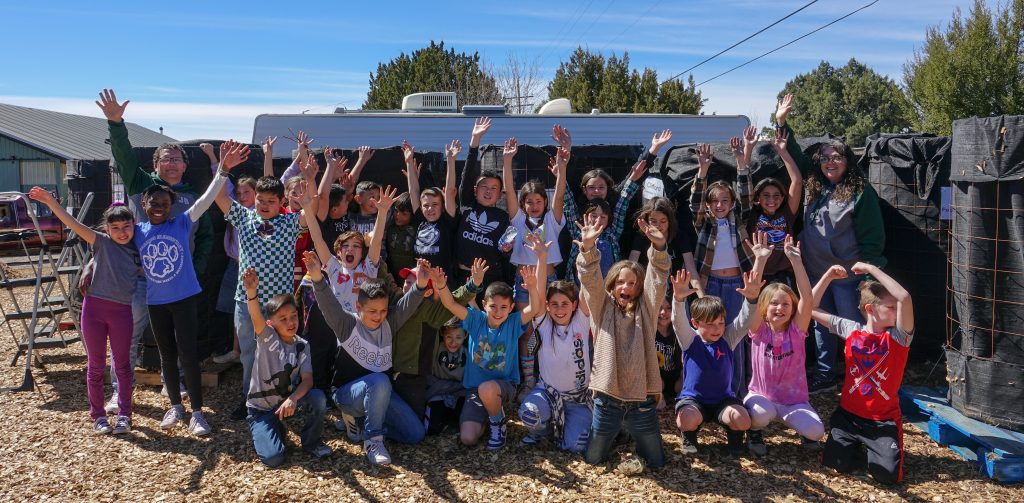
In the summer of 2019, Laura Ramnarace, a volunteer at Silver City’s KURU, had an idea for a new show.
The program already had a name, Kindred Continuum, and a mission.
Dedicated, as described on the station’s website, to “covering our relationship to nature, the creation of a more beautiful world for us all, indigenous issues and the place where art and social justice meet,” the series would be presented in a rotating four-part structure. Each Monday of the month would bring a different show with a different format and a different host, varied perspectives with a shared goal.
Currently, the series includes: The Equity Hour hosted by Cindy “Renee” Provencio and Kit West, a talk-and-interview consideration of social justice issues made personal; Poetry Bread hosted by Howie Richey, a celebration of spoken word arts, of community voices; New Earth Kids hosted by Nan Franzblau, stories of kids working to better the local environment; and Tilantongo: Conversations from Indigenous Mexico, a bi-lingual interview program hosted by Phil and Kathy Dahl-Bredine, former Silver City residents now citizens of Oaxaca.
Intrigued by the program’s design, I contacted Nan Franzblau with questions about the creation and endurance of the show and its rotating format. Nan Franzblau then generously gathered responses–from program creator Laura Ramnarace, from program hosts (present and past), from Marcus Hanson, KURU’s recently retired General Manager–and sent them on to me.
Here are their stories.
Responses have been edited for length and sequence.
Diane: Let’s start at the program’s beginning with Laura Ramnarace. What is the story of the program’s creation?
Response from Laura Ramnarace: The series [Kindred Continuum] was conceived in the summer of 2019 to foreground some of the elements in [what] Charles Eisenstein [called for in his 2013 book]--The More Beautiful World Our Hearts Know Is Possible. These include our relationship to nature, indigenous issues, and social justice and creative endeavors. By presenting the work that people in our community are doing, we bring a sense of possibility to the present and the future.
I came up with the name. “Kindred” refers to the connection among all life forms, that we are all kin, family. “Continuum” refers to the spectrum of life – bacteria, virus, fungi, plants, animals, humans, and all the differences and connections within humanity.
Diane: How did the 4-part approach come about?
Laura: [It seemed] that a weekly show covering all these issues would be a bit onerous for one host but that four different monthly shows could cover the territory more durably. I worked in partnership with the other hosts. Initially, I hosted Resilient Voices, which ran until 2021 as one of the programs in the series, and, for a few months, KURU volunteer Soraya hosted Wild Roots, a program about the state of wild nature in the age of the Anthropocene.
Diane: So, now, let’s hear from each of the hosts. We’ll follow the monthly sequence.
Renee and Kit, I know that your program The Equity Hour is rather new, as the previous Monday program, Interconnect with Kirsten Lundgren, ended in 2024. Can you tell us about yourselves and launching your program.
Response from Cindy “Renee” Provencio: I got my start as a replacement co-host for a KURU show called Gender Trouble with Susan Golightly. I thought my passion, activism and education made me a good fit. I have a Masters in Multicultural Women’s and Gender Studies and came on KURU as a guest a number of times to talk about my thesis research which was the first publication about segregation and discrimination in the southwestern United States.
When Susan decided she could no longer do the show, I set out to find a new co-host. A mutual friend connected me to Kit West. Together we decided a new show would be born that would cover social justice issues beyond the intersection of gender.
Response from Kit West: Silver City is a small town. A lot happens by word of mouth. I have made appearances as a guest poet, reading my work on shows both in Silver City and Ft. Collins, Colorado; and I’ve taught English Literature, Creative Writing and Spanish Conversation at the college level. A friend knew I wanted to be more active politically and put me in touch with [Renee].
Responses from Cindy “Renee” Provencio and Kit West: The Equity Hour had its debut in August 2024.
The show discusses social justice issues in a way that makes them personal, relevant and understandable. For example, we started off with a series on Project 2025 which aired in the months running up to the election. We focused on how Project 2025 would impact women, children and seniors, using a family perspective approach to make the enormous amount of information involved more pertinent.
We used a similar approach with our next series on immigration, demystifying this issue, making it about people, not just politics. We demystified by interviewing experts on the topic at hand. For example, we started the immigration series by interviewing Felip Millan, an immigration lawyer with 30+ years of experience from El Paso, Texas. We brought important information and advice to listeners in preparation for Trump’s massive deportation plans.
Our current series is on trans issues. We plan to cover many other social justice topics such as more on LGBTQIA+ rights and discrimination, Climate Justice, Gun Violence and Gun Control, Native American Rights, Affordable Housing, Homelessness, Behavioral Health, and Police Reform.
Diane: Now, the second Monday program, Poetry Bread. First from Sam Castello, its original host.
Response from Sam Castello: Poetry Bread was founded around 2016. Co-founder Damien Davies and I had been running Silver City Slam, a PSi [Poetry Slam, Incorporated] group, since early 2008; but I was bored with the slam format. I looked for a way to coax local poets onto the stage without the threat or reward of Olympic-style scoring and audience participation.
On January 6th, 2017, Poetry Bread officially held its first live event: a poetic interpretation of Twelfth Night. Over the following four years, Poetry Bread developed into a community of local poets meeting periodically to create and present new poems on topics such as the Canterbury Tales, Hall & Oates, Star Trek, the sun and moon, and Molly Ringwald.
When the pandemic hit in 2020, our ability to meet in-person was taken away. Poetry Bread took to the airwaves as a radio broadcast on KURU. The program debuted on Monday, January 11, 2021, as a part of the Kindred Continuum series. Local poets submitted their work electronically. While coffee shops and cafes were closed, every fourth Monday of the month, poetry from Silver City and across the country was played while we all waited for the storm to pass. In those days, we weren’t allowed to let anyone into the studio with us. In fact, we were discouraged from coming ourselves unless we absolutely had to. Instead, I produced the show from home with submissions from local poets and scoured the Internet and friends’ CD collections for poems to play. In uncertain times, there was at least the promise of hearing each others’ voices once a month.
Eventually things got back to “normal” and we started broadcasting live in-studio. In November of 2022, Howie Richey agreed to take on the program as its regular host, and it’s been a joy to listen to.
As far as the name, well, sometime in the early twenty-teens, a group of Silver City poets were in Albuquerque for a slam. After a raucous night of poetry at the venue, we moved on to an even more rowdy night of post-show festivities at the home of one of the local poets. One of them fell asleep on the couch. He woke up and found a congregation of us poets in the kitchen trading verses and swapping rhymes (the best party is always in the kitchen). When he announced that he was hungry, the suggestion was made that he should fix a sandwich—but no one knew where the bread was. Someone found it, and, like a prophet in the wasteland, held the loaf aloft and proudly announced “I HAVE THE POETRY BREAD!!!” The room erupted into applause, and sandwiches were enjoyed by all.
And that is how Poetry Bread was born; it showed up when it was kneaded most.
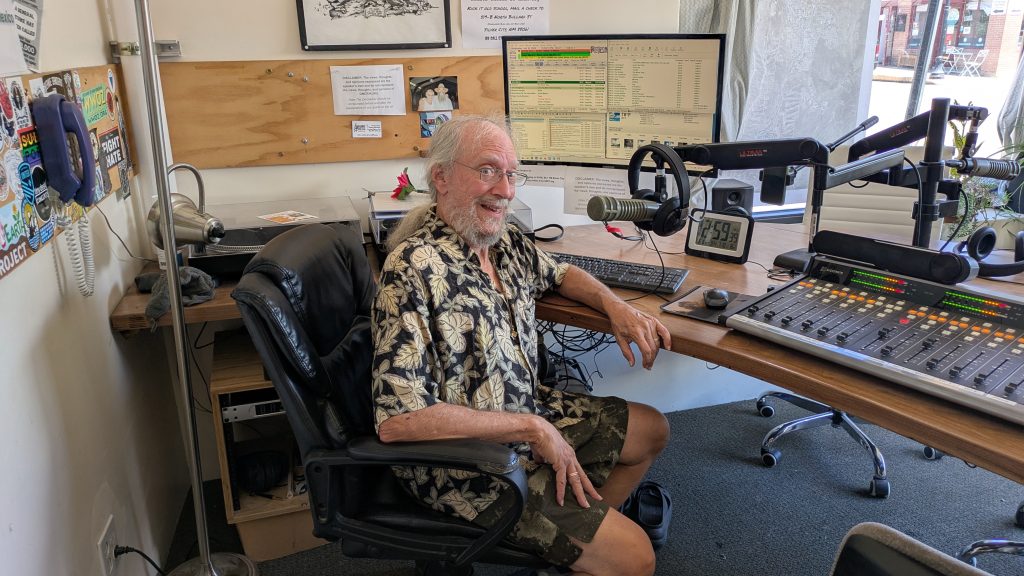
Diane: And, now, from Howie Richey, its current host.
Response from Howie Richey: I first heard about the poetry show when my wife, Linda, conducted an internship residency [in Silver City] for Power and Light Press in late July of 2022. We were visiting from Austin, Texas, and experiencing great infatuation for the town. She taught local writers how to self-publish their work with handmade books.
Because of my experience in public radio, I got to host Poetry Bread on August 8. Members of the class appeared live on-air reading their rhymes and verses. It was a fab experience, something I could easily do again.
We went back to Texas, but Southwest New Mexico kept calling. We returned in late September for the Gila River Fest and began flirting with real estate. Around this time, the show needed a new host, so I stepped up, producing the program remotely from Austin.
By February of 2023, Linda and I just could not stay away from Silver. She led another bookbinding workshop that month, and I did Poetry Bread live on the 13th. On February 27, we toured the house that we ended up buying. Infatuation blossomed into a committed relationship.
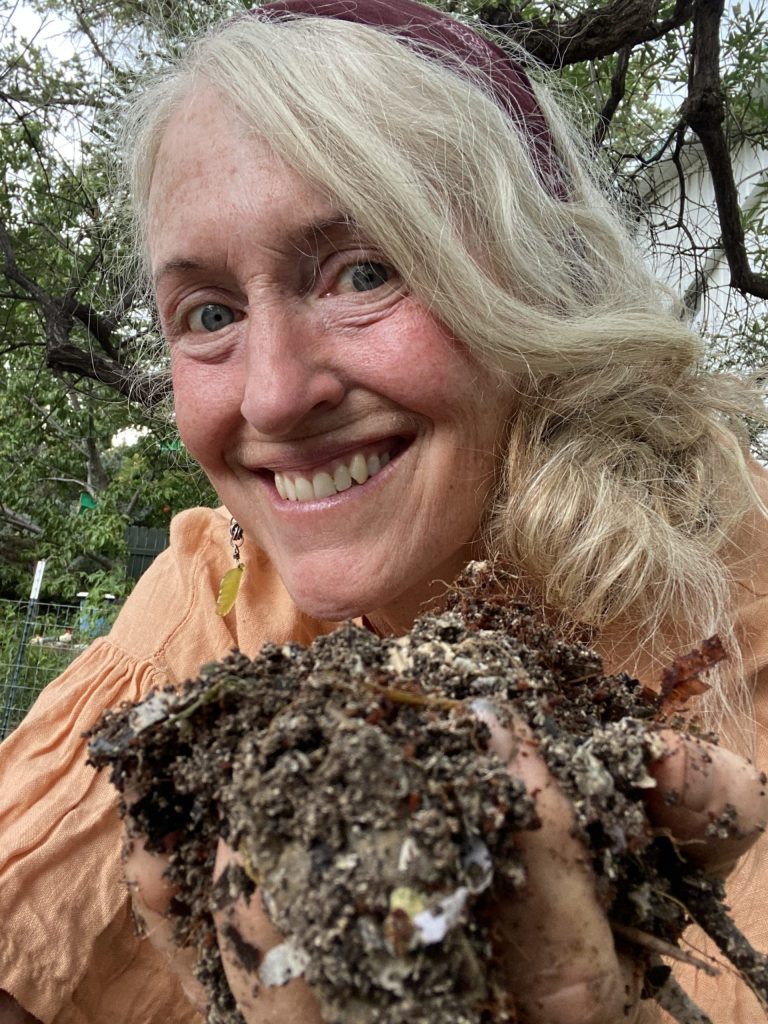
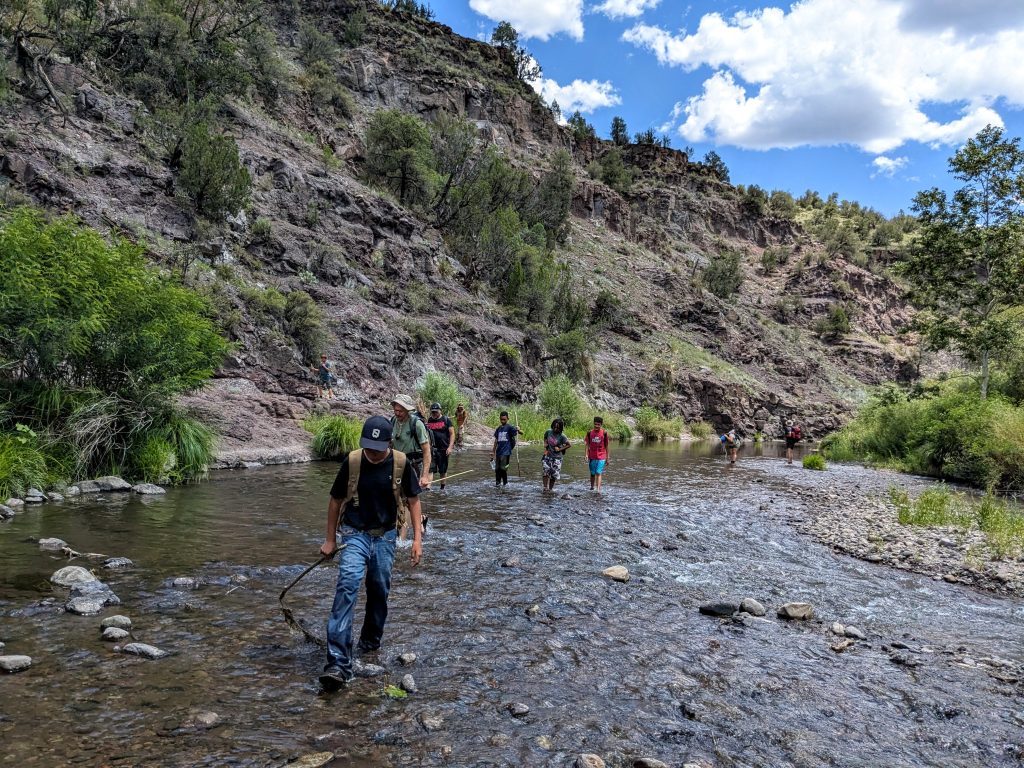
Diane: Nan, let’s turn now to New Earth Kids.
Responses from Nan Franzblau: When I joined KURU in 2017, the station was just a few years old. I created a weekly music show called Rambling Radio Revival which still provides me with opportunities to share the music I love.
In 2022, I began working with a Silver City nonprofit called the Upper Gila Watershed Alliance (UGWA). We launched the New Earth Project, a carbon drawdown program through which we compost 1400 pounds of leftover cafeteria food every week. In addition to climate mitigation, we focus on promoting soil regeneration, youth empowerment and education. As the New Earth Project’s Education Director, I helped create a curriculum that includes 4th graders raising redworms in their classrooms, conducting soil experiments, and learning about the carbon cycle. Kids are environmentalists at heart, and we quickly realized that their voices need to be heard! Thus, New Earth Kids was born.
New Earth Kids puts a spotlight on kids of all ages in southwest New Mexico and what they are doing to find and implement solutions to address environmental concerns. Episodes of New Earth Kids produced so far (16 and counting!) have featured the kids behind a garden-to-table program at a local elementary school, 5th graders who created a series of giant murals depicting redworms breaking down organic waste, a high school Eco-monitoring group, Youth Conservation Corps projects, and an interview with two high school graduates who attended a youth legislative training, one of whom is the youngest-ever member of a local town council.
New Earth Kids accomplishes what we originally set out to do: inform listeners in the community about kids’ concerns and how kids are taking action. But, through our stories and interviews, we also prove to kids that their ideas and experiences are valuable and worth sharing. New Earth Kids connects people and builds our community’s resilience in the face of climate change. Listeners frequently comment about how much they enjoy hearing the kids share their experiences and about the innovative ways kids are caring for the world we live in. By educating listeners about youth activism, we hope to inspire people to support them. New Earth Kids gives everyone hope for the future.
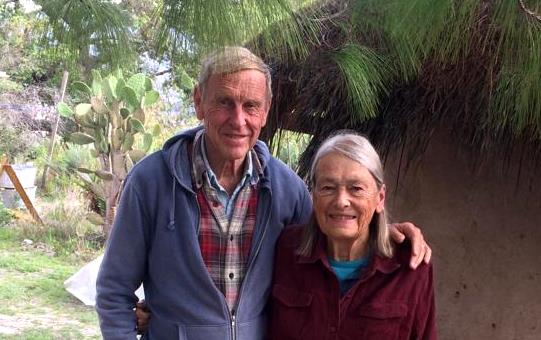
Diane: And, finally Tilantongo hosted for KURU from Oaxaca.
Responses from Kathy and Phil Dahl-Bredine: Tilantongo: Conversations from Indigenous Mexico is just what its name implies. In a time when communication with other peoples and cultures, in spite of our communication technologies, is often skewed by our own preconceptions and understandings, these bi-lingual conversations with Indigenous farmers, leaders, and activists from the mountains and Indigenous pueblos of Oaxaca allow them to speak in their own voices.
We, who have lived [for] over 20 years as members of a small Mixtec campesino community in the historic pueblo of Santiago Tilantongo, lead a quickly shifting Spanish/English conversation that preserves the Spanish voices speaking with their own inflection and emotion about their lives, struggles, and community values.
“Why is harmony such a key concept in indigenous cultures?” “Why is accumulation not a goal for the indigenous peoples of Oaxaca?” “How is it that indigenous communities of Oaxaca can still be practicing a thousand-year-old democracy modeled on the wisdom of their ancestors?” “How does climate change threaten the existence of these farming communities?” “Why would rebellious indigenous leaders proclaim that ‘…free trade treaties mean the death of indigenous communities?’” “What is the true significance of fiesta in the pueblos of the mountains of Oaxaca?”
“And what do the indigenous communities here have to teach us about community, about the natural world, or about the human condition?” A careful listener to Tilantongo: Conversations from Indigenous Mexico will realize that he or she is listening to words from another concept of civilization that is at odds with many of our civilization’s fundamental perceptions and which has some crucial lessons to teach us.
Phil Dahl-Bredine: Kathy and I raised our seven children in Silver City and in 2001 moved to the state of Oaxaca, Mexico to work with apiculture projects and young children in Indigenous communities with an organization called Maryknoll.
We stayed and are Mexican citizens and citizens of the village of San Isidro Yukuyoko in the mountains of the Mixteca Alta. Our contacts with friends and family in Silver City facilitated cooperation with KURU, with Jamie Newton [KURU Board of Directors Chair Emeritus], and with Kindred Continuum. The program’s commitment to “deepening the conversation” gives us the opportunity to invite local people to share the profound wisdom of the Indigenous vision and communal life that living twenty years as part of the community of Yukuyoko has taught us.
Diane: The programs in this series are all strengthened by engagement with a particular aspect of the local environment. I’m interested in hearing about Silver City, New Mexico, those connections, and the founding of KURU.
Nan, given your program’s emphasis on environmental issues, let’s start there.
Nan Franzblau: Silver City is nestled in the foothills of the Gila National Forest in southwest New Mexico. Just a few miles to the west, the Continental Divide stretches south to Mexico and north to Canada. Hikers, birders, and wilderness lovers from all over the world come to the Gila (Hee-lah), which encompasses America’s first designated wilderness, created over 100 years ago and championed by naturalist Aldo Leopold.
Diane: And that natural beauty has helped to create a vibrant and engaged contemporary community?
Nan: Tourists flock to Silver City to explore the wilderness, shop in the downtown arts district, come to our decades-old Blues Festival, watch (or ride in) our world class cycling Tour of the Gila, soak in one of many hot springs in the area, marvel at our 40+ locally made murals, or attend one of our many community events. We are also home to Western NM University, a 4-year school that hosts top-tier performers and cultural events.
Diane: Tilantongo ties the city both to Mexico and to an indigenous past. Can you talk about those connections?
Nan: There is evidence that these lands have been occupied for over 4000 years. 1000 years ago, the Mimbrenos people roamed the lands surrounding Silver City and left behind intricate cliff dwellings and Mimbrenos pottery. In the late 1500s, what are now Silver City and the satellite communities of Gila and Mimbres became campsites of the Chiricahua and Warm Springs Apache people. Apache medicine man and military leader Geronimo was born near the headwaters of our beloved Gila River in 1829.
Diane: And Laura said that for about a year the early series sequence included Smoke Signals, Apache Style hosted by local Apache leader Joe Saenz, a program that featured discussions on Apache culture and history, ancient and contemporary issues, the return to their traditional territory as well as Native music.
Nan: The Spaniards’ arrival marked the beginnings of copper mining for this region, and the discovery of silver ore attracted a wave of prospectors and led to the founding of Silver City in 1870. The Tyrone and Santa Rita copper mines have provided the basis of our local economy ever since and help sustain the mining district communities of Bayard, Santa Clara & Hurley.
Diane: And, in a final connection, this is a community that has built a strong local station.
Nan: It comes as no surprise that such a creative, caring and conscientious community would spawn a local radio station. KURU began broadcasting over the air in 2013, after several years of community planning and raising money. With a mission to serve the underserved, provide a voice for the community, and be a foundation for events, information and entertainment, KURU is 100% listener-supported, relying on donations from individuals and local businesses. We currently have over 150 monthly and annual donors. Our historic building in downtown Silver City was donated to us by generous residents Suzi Calhoun and Janey Katz, and our studio has received a recent equipment upgrade, thanks to a $30,000 grant from the local 30something philanthropic group.
KURU boasts more than 35 local program hosts, who cover a wide array of music shows, interviews with local government and non-profit leaders and event organizers, and local news. High school interns and students from WNMU add to our diverse programming.
KURU is the 2nd most powerful radio station in Grant County. Our FM signal reaches about 30,000 people. We also stream live at gmcr.org.
We are also glad to air syndicated talk and music programs from the Pacifica Network. Democracy Now, Economic Update, and the Ralph Nader News Hour are some of our listeners’ favorites.
Diane: And how has that affiliation helped the station?
Response from Marcus Hanson: Affiliation provides our listeners with options ranging from talk on all sorts of topics to music of every imaginable genre. It allows us to expand our programming beyond local talk and DJs, creating a diverse range of programming that our listeners enjoy.
Additionally, being an affiliate station allows us to attend the monthly (formerly weekly) webinars that cover topics such as general radio station operations and that provide a roundtable platform. This has been instrumental in our growth as a station, as it allows us to hear and share ideas in a very niche industry. Hopefully as time goes on, stations like ours will continue to pop up over the country and we won’t be so niche anymore.
Diane: It feels fitting to end on a note about the value of collaboration. Kindred Continuum–its content and its varied formats, its support of local initiatives, its balance of discourse and art, the lines you draw from the youngest residents to the voices of an Indigenous culture, the love of and respect for all languages–is an example of how every day local radio strengthens and enriches community life.
Thank you all. And a very special thank you to Nan Franzblau for her generous and dedicated work gathering these stories.
Kindred Continuum airs every Monday at 10 AM & each show is replayed on the air the following Sunday at 4 PM on KURU 89.1 FM in Silver City, New Mexico. Shows can be livestreamed at kuru891.org or gmcr.org. Shows can also be accessed through the station archive at kuru891.org or gmcr.org.
All photos courtesy of KURU.
